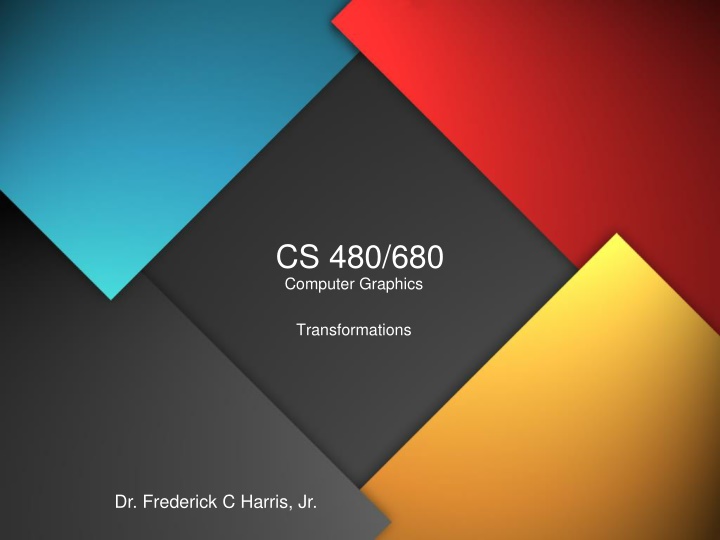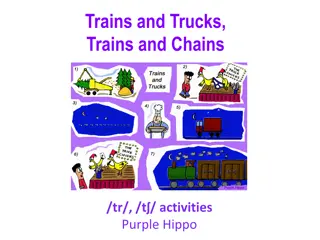
Computer Graphics Transformations and Implementations
Explore standard transformations like Rotation, Translation, Scaling, and Shear in computer graphics. Learn about homogeneous coordinate transformation matrices and the significance of Affine and Pipeline implementations.
Download Presentation

Please find below an Image/Link to download the presentation.
The content on the website is provided AS IS for your information and personal use only. It may not be sold, licensed, or shared on other websites without obtaining consent from the author. If you encounter any issues during the download, it is possible that the publisher has removed the file from their server.
You are allowed to download the files provided on this website for personal or commercial use, subject to the condition that they are used lawfully. All files are the property of their respective owners.
The content on the website is provided AS IS for your information and personal use only. It may not be sold, licensed, or shared on other websites without obtaining consent from the author.
E N D
Presentation Transcript
CS 480/680 Computer Graphics Transformations Dr. Frederick C Harris, Jr.
Objectives Introduce standard transformations Rotation Translation Scaling Shear Derive homogeneous coordinate transformation matrices Learn to build arbitrary transformation matrices from simple transformations
General Transformations A transformation maps points to other points and/or vectors to other vectors v=T(u) Q=T(P)
Affine Transformations Line preserving Characteristic of many physically important transformations Rigid body transformations: rotation, translation Scaling, shear Importance in graphics is that we need only transform endpoints of line segments and let implementation draw line segment between the transformed endpoints
Pipeline Implementation T (from application program) frame buffer T(u) u transformation rasterizer v T(v) T(v) T(v) v T(u) u T(u) vertices vertices pixels
Notation We will be working with both coordinate-free representations of transformations and representations within a particular frame P,Q, R: points in an affine space u, v, w: vectors in an affine space , , : scalars p, q, r: representations of points -array of 4 scalars in homogeneous coordinates u, v, w: representations of points -array of 4 scalars in homogeneous coordinates
Translation Move (translate, displace) a point to a new location P d P Displacement determined by a vector d Three degrees of freedom P =P+d
How many ways? Although we can move a point to a new location in infinite ways, when we move many points there is usually only one way object translation: every point displaced by same vector
Translation Using Representations Using the homogeneous coordinate representation in some frame p=[ x y z 1]T p =[x y z 1]T d=[dx dy dz 0]T Hence p = p + d or x =x+dx y =y+dy z =z+dz note that this expression is in four dimensions and expresses point = vector + point
Translation Matrix We can also express translation using a 4 x 4 matrix T in homogeneous coordinates p =Tp where 0 1 0 0 d x 1 0 d y T = T(dx, dy, dz) = 0 0 1 d z 0 0 0 1 This form is better for implementation because all affine transformations can be expressed this way and multiple transformations can be concatenated together
Rotation (2D) Consider rotation about the origin by degrees radius stays the same, angle increases by y = r sin ( + ) x = r cos ( + ) x =x cos y sin y = x sin + y cos x = r cos y = r sin
Rotation about the z axis Rotation about z axis in three dimensions leaves all points with the same z Equivalent to rotation in two dimensions in planes of constant z x =x cos y sin y = x sin + y cos z =z or in homogeneous coordinates p =Rz( )p
Rotation Matrix R = Rz( ) = cos cos sin 0 0 sin 0 0 0 0 1 0 0 0 0 1
Rotation about x and y axes Same argument as for rotation about z axis For rotation about x axis, x is unchanged For rotation about y axis, y is unchanged sin 0 1 0 0 0 0 cos - sin 0 R = Rx( ) = cos 0 0 0 0 1 cos 0 sin 0 0 1 0 0 R = Ry( ) = - sin 0 cos 0 0 0 0 1
Scaling Expand or contract along each axis (fixed point of origin) S = S(sx, sy, sz) = x =sxx y =syx z =szx p =Sp 0 s 0 0 s x 0 0 s 0 y 0 0 0 z 0 0 0 1
Reflection corresponds to negative scale factors sx = -1 sy = 1 original sx = -1 sy = -1 sx = 1 sy = -1
Inverses Although we could compute inverse matrices by general formulas, we can use simple geometric observations Translation: T-1(dx, dy, dz) = T(-dx, -dy, -dz) Rotation: R-1( ) = R(- ) Holds for any rotation matrix Note that since cos(- ) = cos( ) and sin(- )=- sin( ) R-1( ) = R T( ) Scaling: S-1(sx, sy, sz) = S(1/sx, 1/sy, 1/sz)
Concatenation We can form arbitrary affine transformation matrices by multiplying together rotation, translation, and scaling matrices Because the same transformation is applied to many vertices, the cost of forming a matrix M=ABCD is not significant compared to the cost of computing Mp for many vertices p The difficult part is how to form a desired transformation from the specifications in the application
Order of Transformations Note that matrix on the right is the first applied Mathematically, the following are equivalent p = ABCp = A(B(Cp)) Note many references use column matrices to represent points. In terms of column matrices p T = pTCTBTAT
General Rotation About the Origin A rotation by about an arbitrary axis can be decomposed into the concatenation of rotations about the x, y, and z axes R( ) = Rz( z) Ry( y) Rx( x) y v x y z are called the Euler angles Note that rotations do not commute We can use rotations in another order but with different angles x z
Rotation About a Fixed Point other than the Origin Move fixed point to origin Rotate Move fixed point back M = T(pf) R( ) T(-pf)
Instancing In modeling, we often start with a simple object centered at the origin, oriented with the axis, and at a standard size We apply an instance transformation to its vertices to Scale Orient Locate
Shear Helpful to add one more basic transformation Equivalent to pulling faces in opposite directions
Shear Matrix Consider simple shear along x axis x = x + y cot y = y z = z 1 cot 0 0 0 1 0 0 H( ) = 0 0 1 0 0 0 0 1








